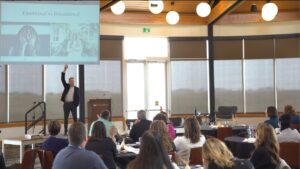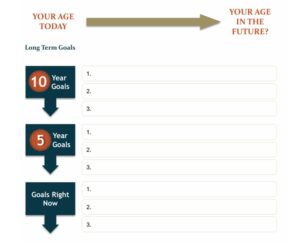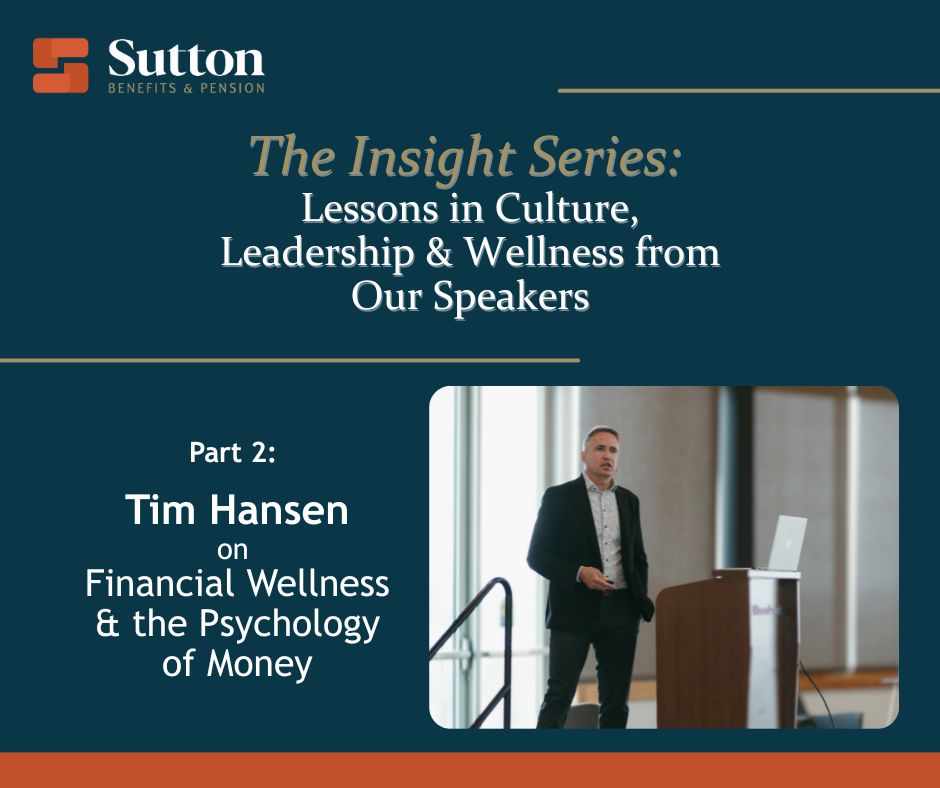At Sutton’s Thriving in Uncertainty event on June 10, 2025, we brought together some of Canada’s most respected voices in leadership, wellness, and workplace strategy. What followed was a day of powerful storytelling, practical tools, and deeply human insights—designed to help employers lead with clarity, compassion, and confidence in a world that’s constantly shifting.
We created The Insight Series—a four-part recap capturing the most impactful lessons from our speakers. Whether you joined us in person or are just catching up now, these summaries are designed to spark reflection, conversation, and action.
The Insight Series Part 2: Financial Wellness & the Psychology of Money with Tim Hansen
In the second installment of our Insight Series, we turn our attention to a topic that resonates deeply in today’s economic climate: financial wellness. Following Jim Brayshaw’s powerful session on navigating uncertainty, Tim Hansen brought a compelling and relatable perspective on how our mindset, habits, and emotional triggers shape our financial decisions.
Tim’s session was more than a financial literacy talk—it was a candid exploration of the psychology of money and how we can build resilience in the face of financial stress. With humour, personal stories, and practical strategies, he helped us reframe our relationship with money and empowered us to take control of our financial future.

Financial Wellness is Emotional Wellness
Financial wellness isn’t just about having money—it’s about feeling secure and confident in your financial decisions. Tim emphasized that uncertainty can be a catalyst for growth if we understand our emotional triggers and adopt intentional habits.

The Psychology of Spending
From impulsive purchases to emotional spending, our financial behaviours are often driven by stress, media influence, and social comparison. Tim encouraged us to differentiate between emotional and intentional spending and to build a resilient mindset: “I am in control of my money. My money is not in control of me.”

Goal Setting Starts with Vision
Tim guided the audience through a powerful exercise: envisioning your life 10 years from now and identifying one small step to move toward that vision. This approach transforms financial planning into a personal, achievable journey.

Cash Flow Clarity is Critical
Understanding where your money goes—whether it’s coffee or boats—is essential. Tim shared tips on using technology to track spending, building emergency funds, and saving 10–15% of gross income to build long-term resilience.

Investing with Logic, Not Emotion
Markets are emotional, not logical. Tim introduced dollar-cost averaging as a strategy to invest consistently and avoid the pitfalls of emotional decision-making. He also highlighted the importance of diversification and understanding your risk tolerance, capacity, and required risk.

Teaching the Next Generation
In a heartwarming close, Tim shared how he taught his children about money using 3 jars: Save, Spend, and Share. This simple system sparked curiosity, responsibility, and generosity—lessons that will last a lifetime.
Closing Reflection
Tim’s session reminded us that financial wellness is a journey rooted in self-awareness, education, and community. As leaders—in our homes, workplaces, and communities—we have a responsibility to foster open conversations about money and to model healthy financial behaviours.
In uncertain times, the most powerful thing we can do is take small, intentional steps toward clarity and confidence. Financial wellness isn’t a destination—it’s a mindset.
Stay tuned next week for Part 3, Martin Chung on Drug Plans, Wellness & What’s Next
…Martin unpacks the “yin-yang of 10,000,” exploring the tension between cost and care in today’s drug landscape. With data and insight, he shows how employers can make smarter, more sustainable benefits decisions.


